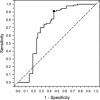Plasma adrenomedullin concentrations in critically ill neonatal foals
- PMID: 24773029
- PMCID: PMC4857949
- DOI: 10.1111/jvim.12358
Plasma adrenomedullin concentrations in critically ill neonatal foals
Abstract
Background: Bacterial sepsis remains a leading cause of morbidity and mortality in neonatal foals, but accurate diagnostic and prognostic markers are lacking. Adrenomedullin (AM) is a polypeptide with diverse biologic effects on the cardiovascular system that increases in septic humans and laboratory animals.
Hypotheses: Plasma AM concentration (p[AM]) is increased in septic neonatal foals compared to sick nonseptic and healthy control foals, and p[AM] is predictive of survival in septic neonatal foals.
Animals: Ninety critically ill (42 septic, 48 sick nonseptic) and 61 healthy foals <1 week of age.
Methods: A prospective observational clinical study was performed. Venous blood was collected from critically ill foals at admission and from healthy foals at 24 hours of age. Critically ill foals were categorized as septic or sick nonseptic based on blood culture results and sepsis score. Plasma [AM] was measured by using a commercially available ELISA for horses. Data were analyzed by using the Mann-Whitney U-test and P < .05 was considered significant.
Results: Plasma [AM] was not significantly different between septic and sick nonseptic foals (P = .71), but critically ill foals had significantly increased p[AM] compared to healthy controls (P < .0001). In critically ill foals, p[AM] was not predictive of survival (P = .051). A p[AM] cutoff concentration of 0.041 ng/mL provided a test sensitivity of 91% and specificity of 54% to predict illness.
Conclusions and clinical relevance: Plasma [AM] shows promise as a marker of health in neonatal foals, but p[AM] increases nonspecifically during perinatal illnesses and is not necessarily associated with sepsis.
Keywords: Foal; Sepsis; Survival.
Copyright © 2014 by the American College of Veterinary Internal Medicine.
Figures


Similar articles
-
Plasma C-reactive protein and haptoglobin concentrations in critically ill neonatal foals.J Vet Intern Med. 2015 Mar-Apr;29(2):673-7. doi: 10.1111/jvim.12568. J Vet Intern Med. 2015. PMID: 25818221 Free PMC article.
-
Utility of cell-free DNA concentrations and illness severity scores to predict survival in critically ill neonatal foals.PLoS One. 2021 Apr 26;16(4):e0242635. doi: 10.1371/journal.pone.0242635. eCollection 2021. PLoS One. 2021. PMID: 33901192 Free PMC article.
-
Serial plasma vasopressin concentration in healthy and hospitalised neonatal foals.Equine Vet J. 2014 May;46(3):306-10. doi: 10.1111/evj.12121. Epub 2013 Sep 11. Equine Vet J. 2014. PMID: 23781864
-
Endocrine dysregulation in critically ill foals and horses.Vet Clin North Am Equine Pract. 2011 Apr;27(1):35-47. doi: 10.1016/j.cveq.2010.12.011. Vet Clin North Am Equine Pract. 2011. PMID: 21392652 Review.
-
Prognostic Indicators for Survival and Athletic Outcome in Critically Ill Neonatal Foals.Vet Clin North Am Equine Pract. 2015 Dec;31(3):615-28. doi: 10.1016/j.cveq.2015.09.006. Vet Clin North Am Equine Pract. 2015. PMID: 26612751 Review.
Cited by
-
A review of equine sepsis.Equine Vet Educ. 2015 Feb;27(2):99-109. doi: 10.1111/eve.12290. Epub 2015 Jan 14. Equine Vet Educ. 2015. PMID: 32313390 Free PMC article. Review.
-
Plasma C-reactive protein and haptoglobin concentrations in critically ill neonatal foals.J Vet Intern Med. 2015 Mar-Apr;29(2):673-7. doi: 10.1111/jvim.12568. J Vet Intern Med. 2015. PMID: 25818221 Free PMC article.
-
Evaluation of updated sepsis scoring systems and systemic inflammatory response syndrome criteria and their association with sepsis in equine neonates.J Vet Intern Med. 2018 May;32(3):1185-1193. doi: 10.1111/jvim.15087. Epub 2018 Mar 26. J Vet Intern Med. 2018. PMID: 29582480 Free PMC article.
References
-
- Cohen ND. Causes of and farm management factors associated with disease and death in foals. J Am Vet Med Assoc 1994;204:1644–1651. - PubMed
-
- Hoffman AM, Staempfli HR, Willan A. Prognostic variables for survival of neonatal foals under intensive care. J Vet Intern Med 1992;6:89–95. - PubMed
-
- Corley KT, Donaldson LL, Furr MO. Arterial lactate concentration, hospital survival, sepsis and SIRS in critically ill neonatal foals. Equine Vet J 2005;37:53–59. - PubMed
-
- Hurcombe SD, Toribio RE, Slovis N, et al. Blood arginine vasopressin, adrenocorticotropin hormone, and cortisol concentrations at admission in septic and critically ill foals and their association with survival. J Vet Intern Med 2008;22:639–647. - PubMed
-
- Stewart AJ, Hinchcliff KW, Saville WJ, et al. Actinobacillus sp. bacteremia in foals: Clinical signs and prognosis. J Vet Intern Med 2002;16:464–471. - PubMed
Publication types
MeSH terms
Substances
LinkOut - more resources
Full Text Sources
Other Literature Sources
Medical

